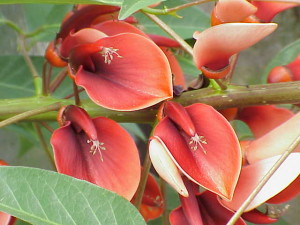
|
|
Coral
Tree flower (Erythrina crista-galli)
|
Coral
Tree - Erythrina crista-galli
Thå genus Erythrina contains in excess of 130 species of deciduous,
semi-evergreen, evergreen trees, shrubs, sub-shrubs and woody-based
perennials, which are often spiny. Erythrina crista-galli is a flowering tree in the family
Fabaceae, native to Argentina, Uruguay, Brazil and Paraguay. It is widely planted as a street or garden tree in other
countries, notably in California in the United States. In South America, it is known by several common
names: ceibo, seibo, bucare. In English it is known as Cockspur coral
tree.
The name Erythrina means coral tree from the Greek word for
red, in allusion to the colour of the flowers. The name crista-galli means cock’s
comb. However, the growth of the branches can resemble the shape of sea
coral, and this is an alternative source for the name.
The tree's flower is the national flower of Argentina and Uruguay. It is also the official city tree of Los
Angeles, California (where it is referred to simply as "the coral
tree").
Erythrina crista-galli is a small
tree, the girth of its trunk measuring 50 cm. Normally, it grows 5–8 meters
tall, although some, such as the ceibos in the Argentine provinces of
Salta, Jujuy and Tucuman, can grow up to 10 m.
The species characteristically grows in the wild within the gallery forest
ecosystem, along water courses as well as in swamps and wetlands. In urban
settings, it is often found growing in parks because of its bright red
flowers.
The root is a taproot which has nodules produced by nitrogen fixing
bacteria. The bacteria live in symbiosis with the tree, facilitating the tree's absorption of nitrogen in return for organic substances which the bacteria
need. The tree's trunk is woody with irregular, spiny branches. These branches form a layer without definite form and die after
flowering.
The trees flower in the summer, from October to April in their native South America and from April to October in the northern
hemisphere. The red flower, arranged in inflorescences of the raceme
type, is pentameric, complete, and of bilateral symmetry. Its calyx is
gamosepalous, like a little red thimble. The corolla, similar to that of Phaseolus
vulgaris, is butterfly-shaped;.
The tree's fruit is monocarpic, dry, of the legume type, and a few centimeters in
length. The chestnut brown seeds are cylindrical in form and are arranged sparesely throughout the seedpod's
interior. The seed germ contains hypogeous cotyledons because the seeds stay underground upon
germination.
All species of Erythrina have
bean-like seed pods. The seeds of over 40 of the species contain
alkaloids, and some of the Amazonian species are used for medicinal and other purposes by indigenous
peoples. Some species have medicinal properties, while others may be
poisonous. The seeds are used for necklaces too.
Source:
http://en.wikipedia.org/wiki/Erythrina_crista-galli
